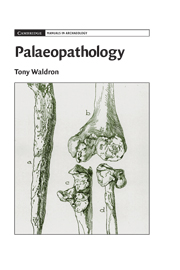Book contents
- Frontmatter
- Contents
- List of Figures
- Preface
- 1 Introduction and Diagnosis
- 2 Bone Metabolism and Pathology
- 3 Diseases of Joints, Part 1
- 4 Diseases of Joints, Part 2
- 5 Bone forming and DISH
- 6 Infectious Diseases
- 7 Metabolic Diseases
- 8 Trauma
- 9 Tumours
- 10 Disorders of Growth and Development
- 11 Soft Tissue Diseases
- 12 Dental Disease
- 13 An Introduction to Epidemiology
- Select Bibliography
- Index
- References
10 - Disorders of Growth and Development
Published online by Cambridge University Press: 05 June 2012
- Frontmatter
- Contents
- List of Figures
- Preface
- 1 Introduction and Diagnosis
- 2 Bone Metabolism and Pathology
- 3 Diseases of Joints, Part 1
- 4 Diseases of Joints, Part 2
- 5 Bone forming and DISH
- 6 Infectious Diseases
- 7 Metabolic Diseases
- 8 Trauma
- 9 Tumours
- 10 Disorders of Growth and Development
- 11 Soft Tissue Diseases
- 12 Dental Disease
- 13 An Introduction to Epidemiology
- Select Bibliography
- Index
- References
Summary
There is considerable interest in growth and development, both historical and anthropological. Growth and development is an area to which the study of skeletal assemblages is able to make a significant contribution. Final achieved height is determined to a great extent by genetic factors and by the influence of hormones, most importantly growth hormone and thyroxin, but in populations which share a similar genetic makeup, the state of nutrition during the period of active growth during puberty is the most significant factor. Thus, it is often taken as a surrogate for the comparison of nutritional status in different skeletal assemblages.
NORMAL GROWTH
As is well known, the growth of the skeleton does not proceed in a uniform manner from birth to adulthood, but there are two major linear growth spurts during childhood: the first during the first two years of life, and the second which begins at puberty. From birth to age one, growth proceeds at a rate of between 18–25 cm, and from one to two, at 10–13 cm per year. The pubertal growth spurt, which is generally supposed to be the most rapid, actually proceeds at the rather more stately pace of 6–13 cm per year. It is, however, more prolonged and is the period during which most height is gained. The importance of genetic factors is well illustrated by the fact that tall parents tend to have tall children, and short parents, short children.
- Type
- Chapter
- Information
- Palaeopathology , pp. 191 - 220Publisher: Cambridge University PressPrint publication year: 2008



